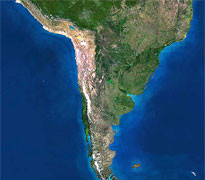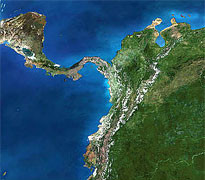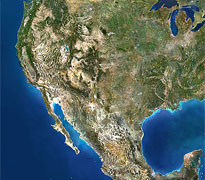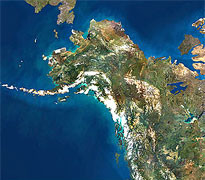This series of concert tours, scheduled for 2015 – 2019, leads the ensemble along the American Cordillera, the mountain ranges near the continents’ western coast, ranging from Tierra del Fuego to Alaska. The tour consists of four stages:
1. Chile and Peru (2015)
2. Ecuador and Costa Rica (2017)
3. Mexico and USA (2019)
4. Canada and Alaska (2020)
Along the Spine’s intention is to enter into a musical exchange and dialogue with musicians and audiences of different kinds of American cultures, using particularly flexible and adaptable concert programmes. The tour and its documentation aims at reinforcing and securing the existence of musical cultural diversity. It is this diversity of cultures, species and environments that makes it possible to experience ourselves inside a thriving and inspiring world. Looking at it that way, the original music of every indigenous ethnic group belongs to our “world’s cultural heritage” which is to be protected and preserved.
The concert tours lead to many different countries, cultures and environments. They pass through practically every climatic and vegetation zone this planet has to offer, through unique ecosystems bursting with an incredible abundance of life forms. It is this biodiversity – the landscapes, the plants and animals who nourish and secure our lives – this project is dedicated to.
For Along the Spine, most different contemporary and traditional music pieces from different genres, countries and cultures are prepared. From this repertoire, we make an individual selection for each concert and each musical encounter, which is broadened by the music of our different hosts, and by pieces worked out together in joint projects with our hosts. All the musical encounters and concerts of the tours are documented in sound and vision.
In addition to that, the ensemble’s members offer workshops for pupils, students and musicians at the respective venues.
Topography
The American Cordillera has a length of 15.000 and a width of 2.500 kilometres, which makes it the longest chain of fold mountains in the world. It stretches from Alaska to Tierra del Fuego. The Cordillera is closely connected to the Pacific Ring of Fire, a volcanic belt encircling the Pacific Ocean. At least two-thirds of all volcanoes that erupted during the Holocene epoch are located here. Also, strong earthquakes triggering tsunamis are concentrated along the subduction zone of the Pacific Ring of Fire.
The American Cordillera forms the western part of that Ring. Many of its high peaks are volcanoes or even volcanic chains. They cross almost all climatic zones of the Earth, from the subpolar regions via the temperate zones and the subtropics through to the tropics. They form glaciers, tundra, coniferous or mixed forests, steppes, sclerophyllous vegetation zones, deserts, savannas or tropical rainforests, and thereby they form an inestimable variety of different habitats for animals, plants and human cultures. But also conurbations of different sizes like Anchorage, Vancouver, Seattle, San Francisco, Los Angeles, Mexico, San José, Bogota, Quito, Lima, La Paz, Santiago or Punta Arenas – to mention a few – they all are situated in the middle of or in the offshore foothills of the Cordillera.
Inspiration
However big the dimensions of those concert tours may seem – a relatively small bird covers that route year after year. During summer, the Arctic tern (Sterna paradisaea) broods in the most northern regions of the Earth, from the boreal zones up to the Arctic. At the end of August, after brooding and raising the brood, they fly down to the Antarctic to spend the winter in the Antarctic summer. A part of the population migrates along the western coasts of North and South America to Tierra del Fuego and further down to the very south of the Indian Ocean. In April, the birds with a an approximate size of 35 centimetres and a weight of 85 to 125 grams leave the Antarctic and return to their breeding areas. That way, those birds cover a distance of 30.000 to 50.000 kilometres per year. They are able to sleep with half of their brain during the flight, while navigating with the other half.
Compared to that miracle of endurance, instinct and sense of direction, our musical-cultural project appears to be realistic and feasible.
Programmes and Music Selection
The music selection for Along the Spine is not restricted to a particular genre like classical music, new music, world music or jazz. Out of a repertoire of various music of our time, we make a selection that suits the respective concert or musical encounter, which is completed by pieces elaborated together with the respective hosts. The selection is supposed to do justice to the various contexts in which the concerts take place. An example is the cooperation project we had with the composition class of the Conservatory in Lima where pieces composed during the 20th and 21st century played the main role. Whereas during musical encounters we had with indigenous cultures – like for example the Q’ero in the Peruvian Andes – our focus was on traditional pieces or improvisation models that allow all participants to play music together.
Some examples of selected pieces
Rabih Abou-Khalil (*1957, Libanon), A Night in the Mountains, for ensemble
Giora Feidman (*1936, Israel), Prayer for Peace, for Clar., vl., vcl.
Sebastian Flaig (*1983, Deutschland), Flüh, for ensemble
Sebastian Flaig (*1983, Deutschland), Der Emul, for ensemble
Morton Feldman (1926-87, USA), Durations, for piano, vcl.
Morton Feldman (1926-87, USA), Nature Pieces, edited for fl., cl., vla., vcl.
Edgar Granda (*1985 Ecuador), Suite Popular Moderna Ecuatoriana, for Guitar solo, arranged for ensemble by Volker Staub
Sofia Asgatowna Gubaidulina (*1931, Russland), De Profundis, for acc. solo
Witold Lutoslawski (*1913-94, Poland), Bukoliki, for vla., vcl.
Astor Piazolla (1921-92, Argentina), Le Grand Tango, for vcl., acc.
José Sosaya Wekselman (*1956, Peru), Girasol Mágico, for fl. and 2 perc.
Volker Staub (*1961, Deutschland), for two to play on one drum, for framedrum duo
Volker Staub (*1961, Deutschland), OEO #1 bis 5, for ensemble
Volker Staub (*1961, Deutschland), Tripa, for ensemble (based on Senegalese rhythms)
Volker Staub (*1961, Deutschland), Unser Meer, for singing and instrumental soloists, choir and orchestra
Volker Staub (*1961, Deutschland), Wiochpeyata, for clar. and playback
trad. Bulgaria, Zwei bulgarische Tänze/Two Bulgarian Dances, arranged for Ensemble by Ruben Staub
trad. Germany, Es geht ein dunkle Wolk herein, arranged for choir and ensemble by Volker Staub
trad. Japan, Hyōjō no chōshi, Gagaku (ca. 12. Jh.), arranged for acc. solo by Eva Zöllner
trad. Klezmer, Dancing with the Rabbi, arranged for ensemble by Volker Staub
trad. Klezmer, Sammy´s Freilach, arranged for ensemble by Ruben Staub
trad. Lakota (USA), Gebetslieder/Prayer Songs, for vioce and drum
trad. Roma, Ederlezi, arranged for ensemble by Nikola Komatina
Nilo Velarde (*1964, Peru), Del mar y sus orillas, for ensemble
Alvaro Zuñiga (*, Peru), In-Móvil, for ensemble (2014/15)
Improvisation Models for different arrangements
We are looking for more pieces by South and North American composers and are grateful for any advice and idea.
Support and Donations
Along the Spine is a non-profit project, which means, none of the participants is remunerated for his great commitment.
Even though the tours are made possible by means of cooperating with different partners from Germany and South America, costs – including the ones for documenting and post-production of recordings – cannot be covered without our supporters.
We therefore kindly ask for donations. We are showing our gratitude to donators donating 25 euros or more by sending them our CD Along the Spine 1 with a music selection we played and got to know during the first part of our tour. In between the music pieces we can hear environmental sounds from places and soundscapes we encountered on our trip.
Each donation, regardless of its amount, helps us with the implementation of this project.
If you would like to contribute to a successful outcome of Along the Spine as well as its documentation, we kindly ask you to contact us so we can send you our account information.
We are looking forward and are grateful for your support for Along the Spine!




